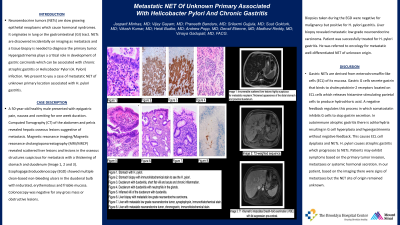Back


Poster Session D - Tuesday Morning
Category: Stomach
D0728 - Metastatic NET of Unknown Primary Associated with Helicobacter pylori and Chronic Gastritis
Tuesday, October 25, 2022
10:00 AM – 12:00 PM ET
Location: Crown Ballroom

Has Audio

Jasparit Minhas, MD
The Brooklyn Hospital Center
Brooklyn, NY
Presenting Author(s)
Jasparit Minhas, MD1, Vijay Gayam, MD1, Praneeth Bandaru, MD1, Srilaxmi Gujjula, MD1, Suut Gokturk, MD1, Vikash Kumar, MD1, Heidi Budke, MD2, Andrew Popp, MD2, Denzil Etienne, MD1, Madhavi Reddy, MD1, Vinaya Gaduputi, MD, FACG2
1The Brooklyn Hospital Center, Brooklyn, NY; 2Blanchard Valley Health System, Findlay, OH
Introduction: Neuroendocrine tumors (NETs) are slow growing epithelial neoplasms which cause hormonal syndromes. It originates in lung or the gastrointestinal (GI) tract. NETs are discovered incidentally on imaging as metastasis and a tissue biopsy is needed to diagnose the primary tumor. Hypergastrinemia plays a critical role in development of gastric carcinoids which can be associated with chronic atrophic gastritis or Helicobacter Pylori (H. Pylori) infection. We present to you a case of metastatic NET of unknown primary location associated with H. pylori gastritis.
Case Description/Methods: A 50-year-old healthy male presented with epigastric pain, nausea and vomiting for one week duration. Computed Tomography (CT) of the abdomen and pelvis revealed hepatic osseous lesions suggestive of metastasis. Magnetic resonance imaging/Magnetic resonance cholangiopancreatography (MRI/MRCP) revealed scattered liver lesions and lesions in the osseous structures suspicious for metastasis with a thickening of stomach and duodenum (Image 1, 2 and 3). Esophagogastroduodenoscopy (EGD) showed multiple clean-based non-bleeding ulcers in the duodenal bulb with indurated, erythematous and friable mucosa. Colonoscopy was negative for any gross mass or obstructive lesions. Biopsies taken during the EGD were negative for malignancy but positive for H. pylori gastritis. Liver biopsy revealed metastatic low grade neuroendocrine carcinoma. Patient was successfully treated for H. pylori gastritis. He was referred to oncology for metastatic well-differentiated NET of unknown origin.
Discussion: Gastric NETs are derived from enterochromaffin-like cells (ECL) of its mucosa. Gastric G cells secrete gastrin that binds to cholecystokinin-2 receptors located on ECL cells which releases histamine stimulating parietal cells to produce hydrochloric acid. A negative feedback regulates this process in which somatostatin inhibits G cells to stop gastrin secretion. In autoimmune atrophic gastritis there is achlorhydria resulting in G cell hyperplasia and hypergastrinemia without negative feedback. This causes ECL cell dysplasia and NETs. H. pylori causes atrophic gastritis which progresses to NETs. Patients may exhibit symptoms based on the primary tumor invasion, metastases or systemic hormonal secretion. In our patient, based on the imaging there were signs of metastases but the NET site of origin remained unknown.

Disclosures:
Jasparit Minhas, MD1, Vijay Gayam, MD1, Praneeth Bandaru, MD1, Srilaxmi Gujjula, MD1, Suut Gokturk, MD1, Vikash Kumar, MD1, Heidi Budke, MD2, Andrew Popp, MD2, Denzil Etienne, MD1, Madhavi Reddy, MD1, Vinaya Gaduputi, MD, FACG2. D0728 - Metastatic NET of Unknown Primary Associated with Helicobacter pylori and Chronic Gastritis, ACG 2022 Annual Scientific Meeting Abstracts. Charlotte, NC: American College of Gastroenterology.
1The Brooklyn Hospital Center, Brooklyn, NY; 2Blanchard Valley Health System, Findlay, OH
Introduction: Neuroendocrine tumors (NETs) are slow growing epithelial neoplasms which cause hormonal syndromes. It originates in lung or the gastrointestinal (GI) tract. NETs are discovered incidentally on imaging as metastasis and a tissue biopsy is needed to diagnose the primary tumor. Hypergastrinemia plays a critical role in development of gastric carcinoids which can be associated with chronic atrophic gastritis or Helicobacter Pylori (H. Pylori) infection. We present to you a case of metastatic NET of unknown primary location associated with H. pylori gastritis.
Case Description/Methods: A 50-year-old healthy male presented with epigastric pain, nausea and vomiting for one week duration. Computed Tomography (CT) of the abdomen and pelvis revealed hepatic osseous lesions suggestive of metastasis. Magnetic resonance imaging/Magnetic resonance cholangiopancreatography (MRI/MRCP) revealed scattered liver lesions and lesions in the osseous structures suspicious for metastasis with a thickening of stomach and duodenum (Image 1, 2 and 3). Esophagogastroduodenoscopy (EGD) showed multiple clean-based non-bleeding ulcers in the duodenal bulb with indurated, erythematous and friable mucosa. Colonoscopy was negative for any gross mass or obstructive lesions. Biopsies taken during the EGD were negative for malignancy but positive for H. pylori gastritis. Liver biopsy revealed metastatic low grade neuroendocrine carcinoma. Patient was successfully treated for H. pylori gastritis. He was referred to oncology for metastatic well-differentiated NET of unknown origin.
Discussion: Gastric NETs are derived from enterochromaffin-like cells (ECL) of its mucosa. Gastric G cells secrete gastrin that binds to cholecystokinin-2 receptors located on ECL cells which releases histamine stimulating parietal cells to produce hydrochloric acid. A negative feedback regulates this process in which somatostatin inhibits G cells to stop gastrin secretion. In autoimmune atrophic gastritis there is achlorhydria resulting in G cell hyperplasia and hypergastrinemia without negative feedback. This causes ECL cell dysplasia and NETs. H. pylori causes atrophic gastritis which progresses to NETs. Patients may exhibit symptoms based on the primary tumor invasion, metastases or systemic hormonal secretion. In our patient, based on the imaging there were signs of metastases but the NET site of origin remained unknown.

Figure: Biopsy and Imaging
Disclosures:
Jasparit Minhas indicated no relevant financial relationships.
Vijay Gayam indicated no relevant financial relationships.
Praneeth Bandaru indicated no relevant financial relationships.
Srilaxmi Gujjula indicated no relevant financial relationships.
Suut Gokturk indicated no relevant financial relationships.
Vikash Kumar indicated no relevant financial relationships.
Heidi Budke indicated no relevant financial relationships.
Andrew Popp indicated no relevant financial relationships.
Denzil Etienne indicated no relevant financial relationships.
Madhavi Reddy indicated no relevant financial relationships.
Vinaya Gaduputi indicated no relevant financial relationships.
Jasparit Minhas, MD1, Vijay Gayam, MD1, Praneeth Bandaru, MD1, Srilaxmi Gujjula, MD1, Suut Gokturk, MD1, Vikash Kumar, MD1, Heidi Budke, MD2, Andrew Popp, MD2, Denzil Etienne, MD1, Madhavi Reddy, MD1, Vinaya Gaduputi, MD, FACG2. D0728 - Metastatic NET of Unknown Primary Associated with Helicobacter pylori and Chronic Gastritis, ACG 2022 Annual Scientific Meeting Abstracts. Charlotte, NC: American College of Gastroenterology.
